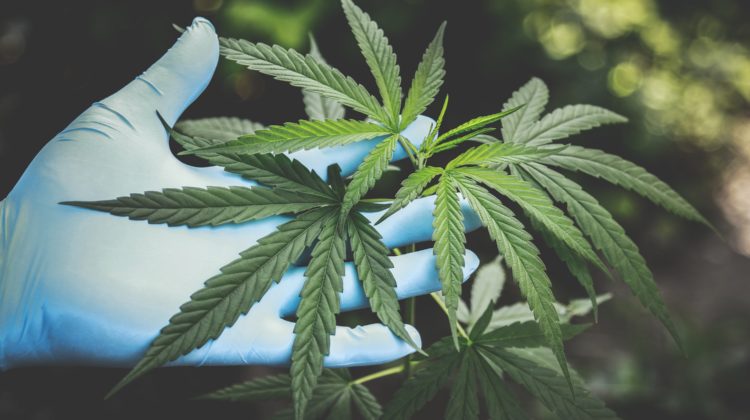
Spring is in the air! Entering this exciting time of year brings new beginnings with longer days and warmer weather. But for the cannabis cultivators and connoisseurs of the world, spring-time signifies the start of the outdoor growing season.
With cannabis legalization becoming more widespread across North America, growing at home is becoming all the rage. In fact, an article published in 2020 by the Toronto Sun claims that one out of seven Canadian cannabis users are choosing to grow their own pot at home.
Not everyone is an expert grower, and that’s okay. Caring for cannabis can be a tricky and sensitive task. So to help make things simpler this spring, we’re breaking down the basics of germination and cloning to help get the growing season started.
First, it’s important to note that there are two main ways to start the growing process. That includes germinating and planting seeds, or cloning — which can also be referred to as cutting.

Germinating Seeds
Germination is the process of growing a new plant from a seed, according to Leafly. Germination can also be referred to as “popping” the seed. It is the first step of the growing process and takes place before the seed enters the soil. Germination is not exclusive to cannabis seeds; the method is also commonly used to prepare the seeds of fruits and vegetables.
The most common way to germinate seeds is to use wet paper towels. According to Leafly, the process begins by wetting four paper towels in distilled water to the point that they are soaked but not dripping wet. The next step is to lay two of the paper towels down on a plate, placing the cannabis seeds on the paper towel about an inch apart. Then, cover the seeds with the remaining wet paper towels.
It’s important the seeds are in a dark, warm place. To create this effect, place another plate over the top of the first one to create a “dome” for the seeds. An alternative to using plates would be lining the inside of a plastic sandwich bag with wet paper towels to create a greenhouse-like effect, trapping in heat and moisture.
Lastly, make sure they are kept in a warm space between 70-90 degrees Fahrenheit for best results. Keep an eye on the seeds until they sprout, which takes about seven days.
Pros and Cons of Seeds
Germination can be a process of trial and error and requires patience. But it is definitely worth it when starting with seeds. While some seeds crack and start to sprout quickly, they can take others up to a week. Some seeds might not even crack at all.
According to the seed bank reviews, Royal Queens Seeds, these are the pros and cons of growing from the seed:
PROS |
CONS |
|
|
|
|
|
|
|
|

Cloning
Cloning is exactly what it sounds like. It’s a process that requires a “cutting” from a pre-existing plant otherwise known as the “mother.” Cloning, also known as propagating, is not specific to cannabis. Cloning is used to carry on the lineage of floral and fruit plants. Cloning can seem like a complex task, especially for novel growers. But it is actually easier than it seems.
A cutting from a mother plant is required to start the cloning process. According to Leafly, when sourcing the perfect cutting, it’s best to stop fertilizing the mother plant for a few days leading up to the cutting to allow for the nitrogen to work its way through the leaves. This will help the plant focus on new growth, rather than its roots.
Look for a healthy, sturdy branch for the cutting. Aim to have a clipping long enough that it has at least two nodes or the point on the stem where leaves come out. For the best cut, snip the clone above the node attached to the mother plant at a 45-degree angle. According to SF Gate’s Home Guide, the angled slice increases the surface area of the stem, speeding up the rooting process.
The final step of the cutting process is to dip the stem into a rooting hormone and then place the cutting into a rooting cube or tray. Carefully tend to the clone, with full light 24 hours a day, water and nutrients according to the strain and environment until they are ready to transfer to a bigger soil source. It can take anywhere from 10-14 days for the clone to be ready to transplant.
Mother plants require a higher skill level when it comes to growing, due to the maintenance and space they require. However, novel growers can skip this process altogether and buy soil-ready clones directly from a dispensary or nursery.
But learning to produce your own clones is a great skill to have further down the line, because it can save money in the long run.
Pros and Cons of Cannabis Cloning
Working with clippings from successful mother plants eliminates a lot of guesswork when it comes to growing. But the cloning process still has some complications. According to Royal Queen Seeds, these are the pros and cons of cloning cannabis:
PROS |
CONS |
|
|
|
|
|
|
Germinating VS Cloning – how to Decide on the Right Method
Many recommend that the best option for beginners is to start with the seed because it helps to build skills and to learn every aspect of plant life. Cloning requires delicacy and careful tending to, which could end up being a lot to take on for a new grower.
There are pros and cons to both germinating and cloning. But no particular method is the “right” way to grow cannabis. The process one uses to grow their own cannabis ultimately comes down to preference, or whether she/he wants to breed new strains or perfect an existing plant.


Leave a Reply